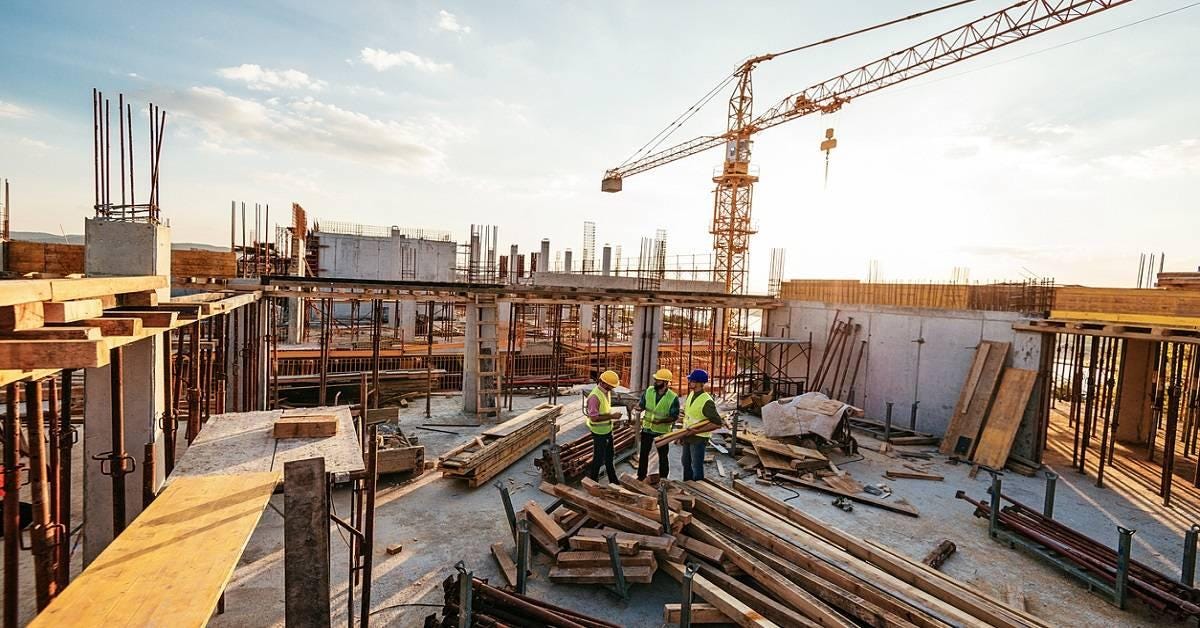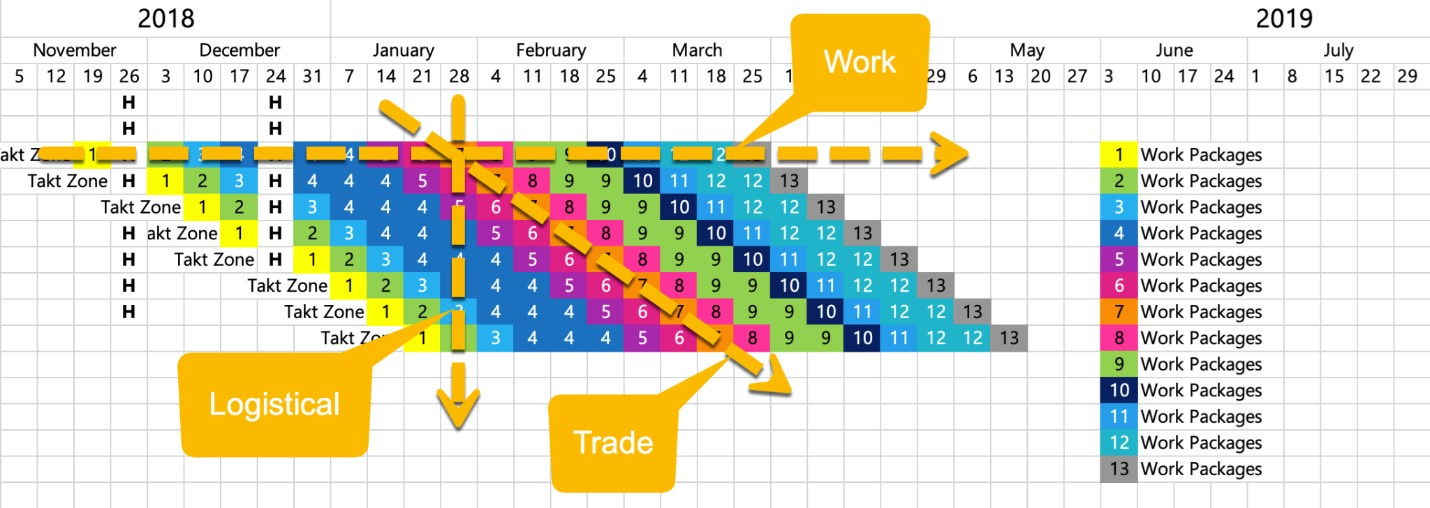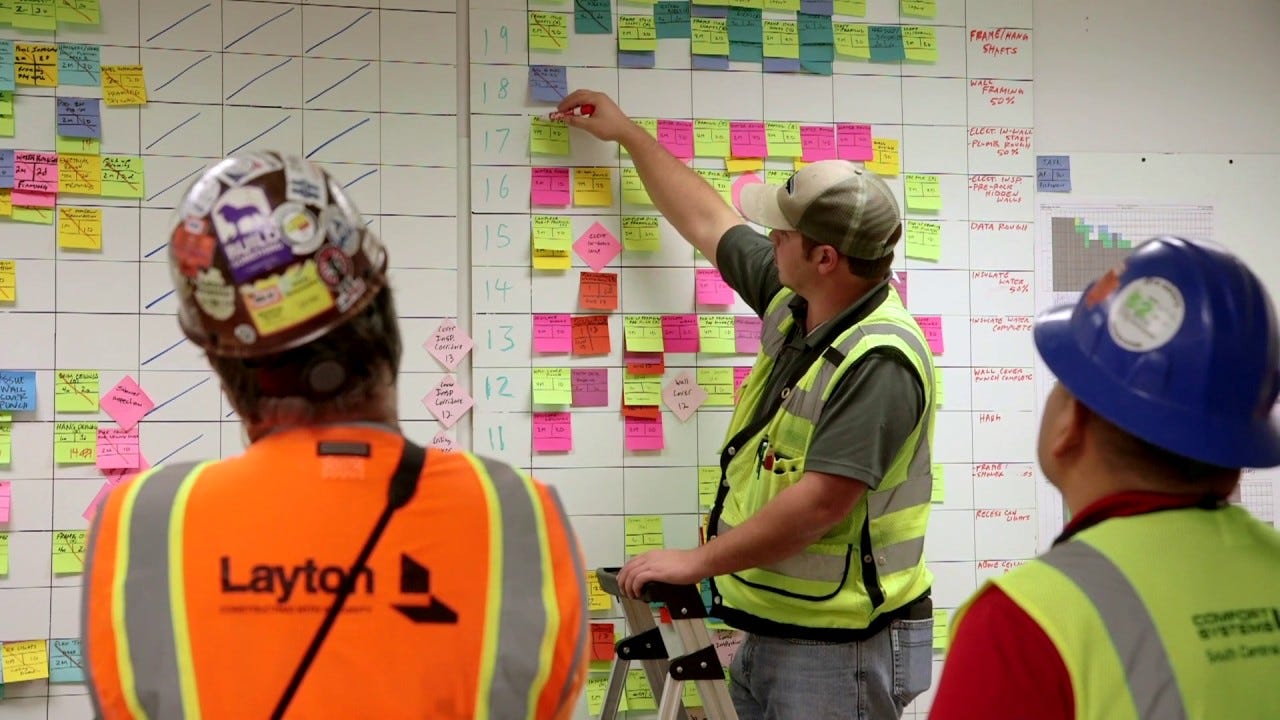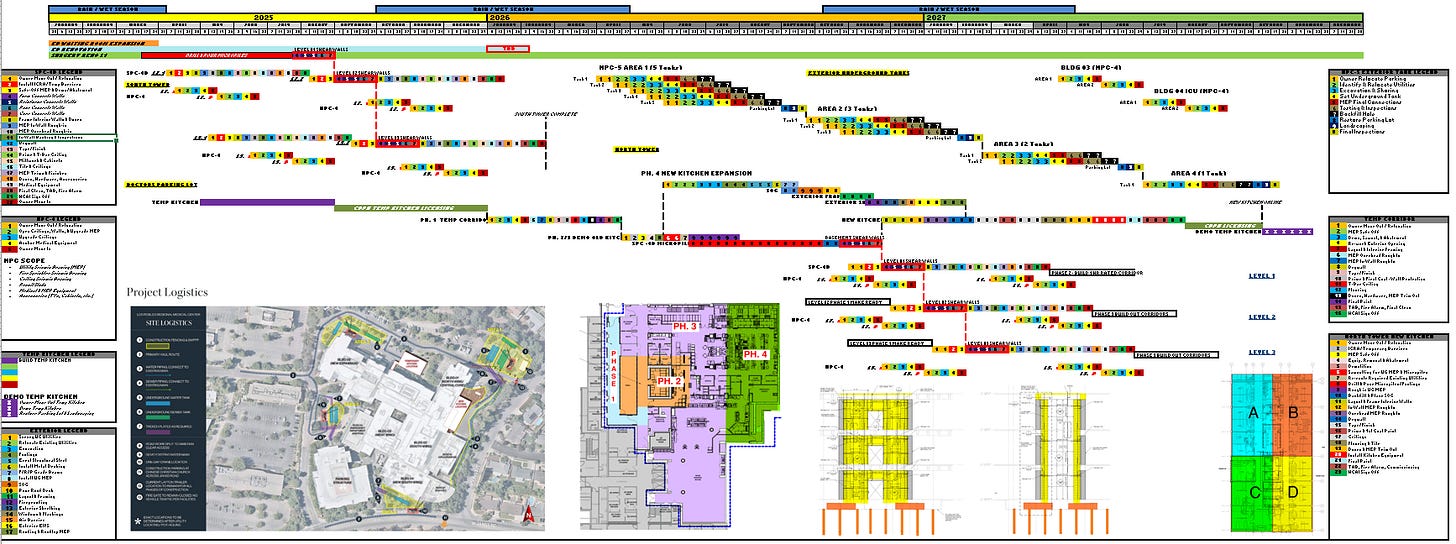👋 Hey, Kyle here! Welcome to The Influential Project Manager, a weekly newsletter covering the essentials of successful project leadership.
Today’s Overview:
After a long dominance of the Critical Path Method (CPM), the methods for construction site planning and management have started to develop and change.
Discover how I tackled the planning of a $100M project to make an entire hospital earthquake-proof by meeting upgraded seismic codes using the Takt Planning & Control framework.
Join me as I walk you through this groundbreaking scheduling method, revealing how you can implement it to optimize your own projects.
🏗️ Inside My $100M Takt Plan: See How I Did It
Filed under: Lean Tools & Tactics, Construction
Hello, my friend!
For years, the Critical Path Method (CPM) has dominated construction site planning and management. But recently, new methods have started to emerge and change the game.
At the beginning of 2023, I was frustrated with our project execution planning. I knew we could improve our processes and outcomes. That’s when I discovered the Takt Production System and decided to take my lean construction journey to the next level.
I dove deep into learning everything I could about Takt planning, combining my research with my experience. Right away, I saw its immense value and potential as a core method for lean construction planning.
Today, I’m excited to share my journey with you. One of my first projects using the Takt Production System is a $100M seismic upgrade to make a hospital earthquake-proof.
The Takt plan created for this project will continue to be updated and used as the:
Master Schedule
Look-ahead Schedule
Weekly Work Plan
Day Plan
And ultimately the project’s production schedule.
The entire plan fits on one clear, easy-to-understand page. I believe this plan sets our project up for success and continuous improvement. I can’t wait to use it alongside the Last Planner System.
Now, you can too!
In this guide, I’ll show you how I created a Takt Plan for my $100M hospital makeover. This method turns scheduling into a simple, one-page plan that captures the workflow perfectly.
We’ll dive right into the system design and how to implement it on your projects. This guide will help you visualize a Takt system and take the steps to implement it on your project.
Before we begin, I want to give a special thank you to Jason Schroeder and Spencer Easton. I’ve learned 95% of what I know about Takt Planning from them. These two are absolute legends in this arena and are doing a wonderful job moving this innovative method forward in our industry. I join them in their belief that Takt will be the new standard of scheduling and planning in construction.
Today’s newsletter is proudly presented by Takt University - stop focusing on speed, and start focusing on FLOW!
Looking for the best training and support for Takt in the construction industry? Check out Spencer Easton's online course: "Takt Planning & Control Introduction." Perfect for beginners and pros alike.
What You'll Learn:
The Basics: Understand the fundamentals of Takt Planning.
Why Takt Matters: Discover its benefits in construction.
Master the Principles: Dive deep into core concepts.
Applying Takt: Step-by-step guidance with a usable template.
90 Day Challenge: Test your skills with real-world applications.
The best part? This course can help you achieve a better work-life balance.
Exclusive Subscriber Discount: Unlock 30% off with the code: “Influentialpmtakt”. Many subscribers expense this course using their learning, professional development, or training budget.
What is Takt Planning?
The Takt Planning is a scheduling system that maps flow through rhythm, continuity, and consistency on a time beat, or Takt, through zones with time on the top and location (the value receiving unit) on the left.
The system stabilizes the project so you can optimize it. It’s made on one page, showing all three types of flow in construction:
The workflow of the actual work.
The logistical flow around the campus.
The trade flow over time and space.
It looks like this:
I’ve learned that schedules for construction projects were always supposed to be formatted in a time by location manner. Then it becomes a 4-D schedule.
Once you can see all the dimensions you can see production principles, lean construction, flow, and all other components of a successful project. We’re about to take a closer look at each component in my example.
Let’s dive in.
Step 1: Identify Your Start and End Date
First, pin down your project’s start and end dates. This sets the boundaries for your planning. Some projects come with fixed dates, while others need you to define them.
For my project, the start date was triggered by the completion of an activity in an adjacent ongoing project. The end date was predetermined by the authority having jurisdiction (AHJ) requiring the hospital to meet new seismic codes.
I designed the plan to fit within those parameters and identified intermediate milestones once the phases were planned.
Step 2: Study Your Drawings
Thoroughly examine your project drawings to understand the phases and flows of work. Study notes, floor plans, and details. Understand the project's full scope in 3D.
Phases are groupings of zones. Think of them as manageable parts where the flow of work through specific locations is the common factor.
It can be helpful to remember this advice:
Find large groups of work that flow together.
Ask: Is your phase a path that a train of trades can flow through?
Link phases together, each with its own flow and type of work.
Typical Phases:
Design
Buyout, Procurement
Demolition
Superstructure
Exterior
Interiors
Site Work
Testing & Commissioning
Step 3: Find Your Flow
After digging into the drawings, builders can get a feel for the general flow of the project. Constraints like staging, material flow, material access, adjacent structures, hoisting, and project access will help form a picture of how the project will generally flow.
Does construction begin from east to west, or west to east?
Does the interior work run from top down or bottom up?
Step 4: Identify Your Takt Zones
Break the work within a phase down by location. Zones are the manageable sections within each phase.
The number of zones you create affects how quickly trades can move through them. Smaller zones generally mean faster progress. Just make sure zones are leveled by work density, not just area or square feet.
For my project, we were building new structural walls in the basement and expanding the building for a new kitchen. I started by breaking the basement floor into grid segments and conducted a work density analysis to ensure balanced zones.
For simplicity, I’ll show you how I did zoning for the basement floor.
Steps to Create Zones:
Study Drawings: Understand the level of effort for each area.
Identify Constraints: Note any obstacles.
Determine General Flow: Plan the sequence and direction of work.
Conduct Work Density Analysis: Break up the floor into grid segments and score work density.
Adjust Zones: Refine zones based on density analysis.
Step 5: Confirm the Takt Time
After creating zones, it’s time to determine the Takt time – the rhythm for your work.
Takt time, in the context of lean construction, refers to the pace at which trade processes move through zones to accomplish the end date.
For my plan, developed in the early stages of the project, it made sense to make the Takt time 5 days.
Later, you’ll modify and update the Takt Plan at a micro level with your last planners, optimizing it using Little’s Law and better coordination with the team.
Step 6: List All Your Activities
Next, I listed all the activities associated with each phase and each Takt zone, including their duration, and package them into a Takt time (e.g., 5 days).
This helps you estimate the number of Takt wagons needed for the phase.
Once you have your list of activities, it’s best practice to find production rates for each activity from historical information, past experience from trade partners, and your builder experience.
Step 7: Pull Plan the Zones
Next, I reached out to some trade leaders that were working on some other projects for me and organized a quick pull planning session.
Having my list of activities organized by phase and zone helped streamline the meeting.
We began building the sequence of the pull plan until no more predecessors or needed activities remain. The team collaboratively pull planned the sequences inside the Takt zones.
It turns out I was close, but I had missed a few key activities and crucial logic. Involving some trade partners was great for catching these details and completing the plan accurately.
Step 8: Package the Work into Takt Wagons
Next, I took each representative Takt Zone and packaged the work into Takt Wagons using a five day Takt time.
A Takt Wagon includes one or more work packages or scopes of work within the same Takt zone and links to other Takt wagons within a Takt train.
I used the following methods to package activities with different durations and speeds into the wagons:
Combine activities together.
Split activities and put them in separate wagons.
Adjust the labor allocated to the activity to slow it down or speed it up.
My preferred method of work-packaging is to create sticky notes in Miro and visually display the package strategy.
After I finished all my packaging, I created the legends for my Takt Plan.
Step 9: Build Your Takt Phases
A Takt sequence or Takt train is a sequence of Takt wagons. Copy the sequence down to other rows in the Takt phase at the right stagger.
Just make sure the stagger fits within the overall project duration (if applicable) or phase duration.
Step 10: Network Your Phases Together
It is important to see all phases of the project and how they network together. This should be done on one sheet regardless of the size of the format.
We want to confirm the proper interdependence ties between design, permitting, coordination, contracting, procurement, mobilization, foundations, superstructure, exterior, interior rough-in, interior finishes, roofing, commissioning, site work, and final inspections.
Without this, we do not have a proper overall project duration with a reasonable end date that will prevent a crash-landing.
Summary
Although there are more steps to the process, you now have a Takt plan at the fundamental level. One of the best ways to get started is to experiment with a Takt template in Excel and just have fun.
Takt Planning shifts the focus from working harder to working smarter. Its beauty lies in its simplicity, condensing complex plans into a clear, one-page overview. This clarity not only helps in identifying and solving problems quickly but also improves decision-making.
I hope this helped you visualize the process. To recap, here is the list of steps in summary:
Identify your start and end date
Research your drawings
Identify the general flow of the project based on known constraints
Identify preliminary Takt zones
Confirm Takt Time
List all your activities (with production rates)
Pull Plan the Zones
Package the Work Into Takt Wagons
Build Your Takt Phases
Network Your Phases Together
Ready to master Takt Planning?
I highly recommend checking out the "Takt Planning & Control Introduction" online course by Spencer Easton. It’s ideal for both beginners and seasoned pros, providing in-depth insights and hands-on Takt Planning techniques so you can start implementing right away.
Good luck! You are about to enter a completely new world of stability and flow.
Until next week,
Kyle Nitchen
🧰 Kyle’s Toolbox
Optimize your project with my partner, INGENIOUS.BUILD:
I get asked about the best project management tools all the time. While my recommendations change, INGENIOUS has been a game-changer for many. I use it to collaborate with all project team members from start to finish.
It replaced a bunch of fragmented processes by bringing everything and everyone into one cloud-based workspace. Seriously, its latest iteration INGENIOUS 2.0 is designed to handle all of your daily operations within project financials, project management, and construction administration. With real-time connectivity and data at your fingertips, it transforms you from an administrative project manager into a strategic project leader.
INGENIOUS.BUILD is offering The Influential Project Manager subscribers a special 5% discount. Take advantage of it today!

Whenever you're ready, there are 5 ways I can help you:
Get my first book! No Bullsh*t Project: A Project Manager’s Guide to Successful Project Leadership
Upgrade your scheduling software. Experience the future planning system for construction and real estate development. iPM subscribers can enjoy a 15% discount on first year license.
Get my full toolbox (free). Access 30+ software and hardware tools I'm using today.
Learn Takt Planning. Elevate your skills as a scheduler, planner, and lean builder with the Takt Planning & Control online course. Use code "Influentialpmtakt" for 30% off.
Advertise in my newsletter. Put your brand in front of 5,500+ construction project managers, leaders, and execs. (Booked out 5 weeks)











